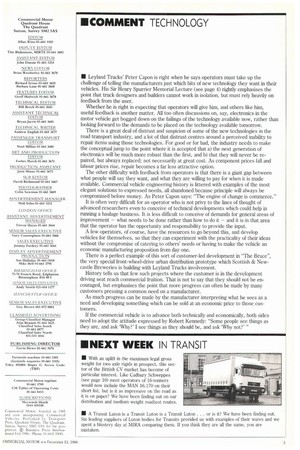II COMMENT TECHNOLOGY
Page 5

If you've noticed an error in this article please click here to report it so we can fix it.
• Leyland Trucks' Peter Capon is right when he says operators must take up the challenge of telling the manufacturers just which bits of new technology they want in their vehicles. His Sir Henry Spurrier Memorial Lecture (see page 4) rightly emphasises the point that truck designers and builders cannot work in isolation, but must rely heavily on feedback from the user.
Whether he is right in expecting that operators will give him, and others like him, useful feedback is another matter. All too often discussions on, say, electronics in the motor vehicle get bogged down on the failings of the technology available now, rather than looking forward to the demands to be placed on the technology available tomorrow.
There is a great deal of distrust and suspicion of some of the new technologies in the road transport industry, and a lot of that distrust centres around a perceived inability to repair items using those technologies. For good or for bad, the industry needs to make the conceptual jump to the point where it is accepted that a) the next generation of electronics will be much more robust than the first, and b) that they will never be repaired, but always replaced; not necessarily at great cost. As component prices fall and labour prices rise, repair becomes a far less attractive option.
The other difficulty with feedback from operators is that there is a giant gap between what people will say they want, and what they are willing to pay for when it is made available. Commercial vehicle engineering history is littered with examples of the most elegant solutions to expressed needs, all abandoned because principle will always be compromised before money. As Peter Capon says: "The engine of change is commerce."
It is often very difficult for an operator who is not privy to the lines of thought of advanced researchers even to conceive of technical developments which could help in running a haulage business. It is less difficult to conceive of demands for general areas of improvement — what needs to be done rather than how to do it — and it is in that area that the operator has the opportunity and responsibility to provide the input.
A few operators, of course, have the resources to go beyond this, and develop vehicles for themselves, so that they can experiment with the practicality of their ideas without the compromise of catering to others' needs or having to make the vehicle an economic manufacturing proposition from day one.
There is a perfect example of this sort of customer-led development in "The Bruce", the very special front-wheel-drive urban distribution prototype which Scottish & Newcastle Breweries is building with Leyland Trucks involvement.
History tells us that few such projects where the customer is in the development driving seat reach commercial fruition. That is not to say that they should not be encouraged, but emphasises the point that more progress can often be made by many customers pressing a common need on a manufacturer.
As much progress can be made by the manufacturer interpreting what he sees as a need and developing something which can be sold at an economic price to those customers.
If the commercial vehicle is to advance both technically and economically, both sides need to adopt the attitude expressed by Robert Kennedy: "Some people see things as they are, and ask 'Why?' I see things as they should be, and ask 'Why not?' "












































































